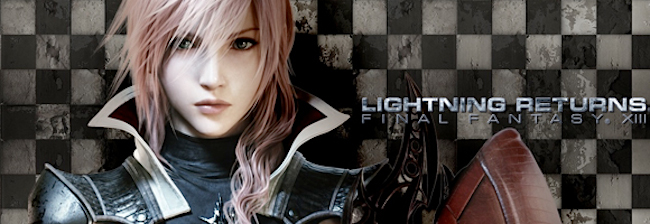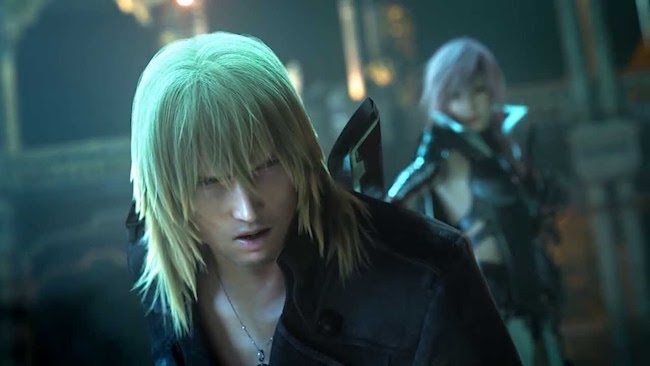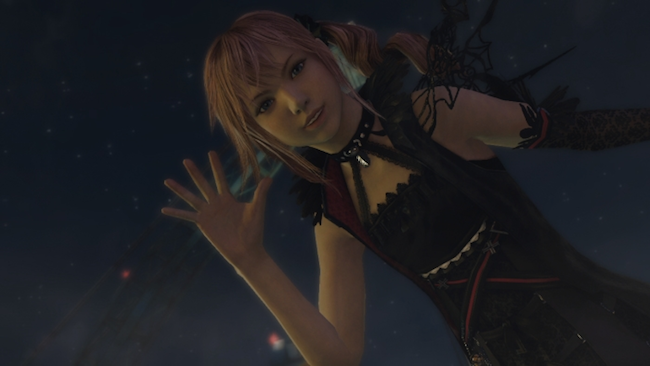
Final Fantasy XIII was a visually stunning game made infamous by its linear design and a plot filled with so many fictional pronouns that you needed an encyclopedia to understand the dialogue. As a longtime fan, even I have to admit that I struggled to find enjoyment within its endless corridors, tutorials, and unnecessary complexity. It was a highly polished game, but its ideas just didn’t execute well when put in practise. It’s follow-up, XIII-2, looked to correct this problem, and I thought it did remarkably well. Noel was a great character, in my opinion, and the time-travel mechanic of the Historia Crux made for a really unique experience. It was well made and reasonably thought out, except, this time, the story had transcended into an utterly confusing mess riddled with needlessly complicated “scientific theory.” However, in saying that, it was a better game than its predecessor in almost every way.
Lighting Returns is a game that was clearly pre-destined, given the unresolved ending of XIII-2. In fairness, I understand the requirements for sequels in the modern gaming age, given the cost of development, and, if done right (and without annual saturation), I believe this can be a good thing. However, I think there was a personal driving force behind the XIII series, and that was Motomu Toriyama – first noted for directing Final Fantasy X-2. To be honest, I felt as if a sense of pride was at stake with both of these sequels, and while Square had proved the mechanics could work well in XIII-2, that was not enough. Fans also had to love the characters, especially Toriyama’s own creation (and passion), Lightning. I appreciate the desire to improve a game, and, in truth, there was a lot “mechanically” I was excited for going in. However, narrative is something that you simply can’t force.

Set 500 years after the events of XIII-2, Lightning Returns takes place during the final 13 days of the world’s existence. Essentially, Lightning has been awoken from her crystallised state by “Bhunivelze” (God) and has been tasked with saving the souls of the living so that they might be reborn on a new world. Basically, after the events of the previous game, time/space has been collapsing in on itself due to the release of chaos from the unseen realm – to the point that there are now only four distinct islands left on the planet and people no longer age or die from natural causes. It’s an interesting premise, but the fact that the team have moved from fighting “lesser” gods known as Fal’Cie, to time paradoxes, and now to working with god himself; it almost feels as if the XIII series has contracted “Dragon Ball Syndrome,” moving from the sublime to the ridiculous in order to keep the story going.
The most interesting aspect of Lightning Returns is that it is an open world game. Essentially, outside of the beginning and the end, you can experience the main quests in any order that you choose. If you think about it, this design is basically the exact opposite of the first instalment. It works well to a certain extent, but the fact that you’re forced to level up by doing lesser quests (I’ll get to that soon), means that most of the game is padded with plot points totally irrelevant to the main story. It’s not that these quests are poorly written – in fact, many are fueled with fan-service and humour. However, the core plot itself is quite short when you look at it separately, and while there were several narrative outcomes I found interesting (and surprisingly less convoluted than before), it still doesn’t feel as if there was enough content to write a complete story. This becomes evident the further you play.

With that being said, there is one thing I just can’t understand. Why would Toriyama create a plot device that basically removes all of Lightnings positive qualities when his goal was for people to like her? Lightning already had a stand-off personality, but now she literally doesn’t care about anything, and it makes for some terribly monotonous dialogue. Worse yet are her tedious conversations with Hope, who provides a running commentary as you play, and more often than not gets cut off mid sentence because he never stops talking. Fortunately, however, the other main characters are more likable than ever, instead exploring the darker persona within each of them – which is something I personally appreciated. In my opinion, if you’re looking for fan service and to see loose ends tied up, you won’t be disappointed. However, if you’re more so interested in the main story, I’m sad to say it, but I suspect fans may feel cheated by its cheap conclusion. It’s not quite Mass Effect 3, but it’s not far off.
Lightning Returns is a game that employs a large variety of unique ideas, and regardless of whether they are successful, it’s important to recognise this willingness to experiment. I appreciate a polished game, but in my role, I also feel the tedium of saturated game design. For this reason, I often enjoy experiences that might fall short of their potential, but still offer new experiences. As an example, this is the first RPG I know of that has completely eliminates the trope of grinding combat in order to get stronger. In Lightning Returns, players are required to complete side quests to earn character growth, and instead focus more on equipment and well thought-out customisation. It’s an idea which doesn’t quite work as the quest structure isn’t the most inspired, but it definitely forced me to re-consider my priorities – which is the first time in this series since the junction system of Final Fantasy VIII.

Customisation is very important in Lightning Returns, and can easily mean the difference between winning or losing an encounter. At first, the concept of playing with “costumes” (garbs) sounds utterly ridiculous, but each of them provides various abilities and bonuses, similar to the concept of the job system. Essentially, the game employs what’s known as a “schemata,” which, to clarify, is kind of like the paradigms from the previous games. However, there are very little restrictions on how you configure your load-outs. There are three schemata at your disposal, and each can hold a weapon, shield, accessory, ring, adornment, and four special abilities. In battle, each schemata also has it’s own ATB gauge, allowing the player to switch between them at will. In essence, it’s almost like controlling three individual characters, and implores careful consideration when configuring each one.
The most interesting mechanic in Lightning Returns, however, is likely the one which will stress or infuriate players who don’t learn how to manipulate it. The game begins with 7 days remaining until the end of the world, and, as you play, the game runs on a real-time clock, running around several minutes for every in-game hour – fully simulating day and night. Important to note, this does not count time in battle, or in the menu, and you do have the ability to earn up to seven additional days. At first, this might sound like a dreadful idea as exploration is a very important component in an RPG, but it’s imperative to note that you can manipulate the world with a commodity known as “eradia” (EP), which is the replacement for experience points. One of the first EP abilities you learn is called Chronostasis, which allows players to stop the clock for a certain amount of time. Do not underestimate its value.

It’s important to understand that this mechanic is a challenge to overcome, not a penalty. It might feel like you’re being rushed, but, in essence, you will have more time than you need if you use these abilities. There is also an unseen eradia which you collect from saving souls (completing quests), and at 06:00 each day, players will be transferred back to “The Ark” (or a home-base if you will). When you arrive, you will offer this unseen eradia to the Yggdrasil (tree of life), and if you collect enough of it, you will be rewarded with extra days. It’s important to note that you will gain the most unseen eradia from the (five) main quests, each of which will guarantee the player another day; essentially leaving only two bonus days to be earned from doing side-quests. It takes a lot to earn these days, so when you hear lightning sigh with disappointment at times, it’s okay, you’re not failing your mission.
With that being said, now that we’ve established that players have the ability to manipulate the hours in the day, as well as the days until the end of the world, where is the problem in this concept? Well, the problem with the time system is that certain areas and people are only accessible at certain times in the day, which means if you miss that time, you will have to wait for the next day. When you have limited days, and your only way to “level up” is by completing side quests, this is where it starts to become stressful, especially if you are poor with time management. There are so many quests, and it is a pain re-reviewing each of them for their time requirements, especially if they involve multiple days, or multiple objectives that take place in different locations. I have never seen a game in which specific time commitments work, and this is the single idea which brings the others down.

If you feared that the game was pursuing the route of an action RPG, you can put those worries to rest. It’s true that Lightning can run, jump, climb, attack, and slide down the occasional pole (kind of pointless?). However, it’s nothing more than a traversal convenience, which, in my opinion, adds some much needed flexibility to the non-combat elements of the gameplay. Furthermore, the player can now move the character while in battle and control her individual attacks though abilities mapped to the buttons on the controller. To clarify, this doesn’t mean you will be bouncing all over the place like in Kingdom Hearts, more so, you will control your position within a battle circle, and block attacks in real-time. If you can learn to block attacks precisely, you can even mitigate all damage. However, this is a lot easier said than done. It’s a polished system, but it’s also very challenging at times.
The battle system is likely the redeeming quality of this game as it implores the player to be smart with their configurations. If you are losing, it’s likely that you either need to reconsider your abilities, buffs, and debuffs, or you need to pinpoint the stagger point of the creature you are fighting. It can considerably cut the time off of a battle if you go in smart, and it is one of the most rewarding systems I’ve ever used. You can’t auto-battle your away through with over-powered physical attacks. It is entirely about strategy, and it’s great that you can also choose to avoid fights all together if you want to. Although, there are benefits, such as gaining items for quests, or regaining EP which can also be used for special abilities in combat, some of which play out like “limit breaks”. Ultimately, it’s your choice how much you value these abilities, but in my opinion, they’re a invaluable commodity.

The world of Lightning Returns is visually interesting, in as much that each of the four areas are very distinct in their design, and personality. From the gothic inspired clockwork city of Luxerion, to the festivals and fireworks of Yusnaan, and all the way out to the grassy villages of The Wild Lands, and the desolate ruins within The Dead Dunes; there is a fantastic contrast. Additionally, each location is filled with towns, shops, quests, and plenty of people, making it the most populated game in the saga; despite the fact children haven’t been born into the world for more 500 years. Importantly, there is now a reason to visit and shop at each location, which is a stark contrast to the all-in-one “E-Store” of it’s predecessor. The world is free for you to explore, and you can travel either through teleportation, or via a subway system. In fact, it is the most realised Final Fantasy world in years.
There is one thing I can’t ignore about the presentation in this game, and that’s the diminishing level of polish between each sequel. Because all the cut-scenes take place directly with the field character models, it sometimes zooms the camera into awkward angles, often displaying many low-res textures that should have gone unnoticed. In fairness, I understand the desire to unify the game, instead of having three separate character models as with the past. However, this is very noticeable during dialogue while the regular game mostly looks quite nice, apart from a few frame-rate drops when there is a lot on screen. In terms of sound design, the game utilises a nostalgic mix or old and new, and I think this works well. My only concern was the monotonous voice acting for Lightning, which often sounds uninspired. However, the Japanese track is free DLC, which is something fans will appreciate.
 The exact opposite of XIII in almost every way
The exact opposite of XIII in almost every way A lot of thoughtful fan service throughout
A lot of thoughtful fan service throughout Schemata customisation is well implemented
Schemata customisation is well implemented Battle system is challenging and rewarding
Battle system is challenging and rewarding Inclusion of Japanese voice over as free DLC
Inclusion of Japanese voice over as free DLC
 Thin narrative with a cheap conclusion
Thin narrative with a cheap conclusion Lightning lacks any sort of personality
Lightning lacks any sort of personality Padded with uninspired fetch quests
Padded with uninspired fetch quests Time mechanic trips over its own feet
Time mechanic trips over its own feet Lacks the visual polish of previous games
Lacks the visual polish of previous games
Lightning Returns is the exact opposite of its original predecessor in almost every way, and this is a good thing. It’s an open world, full of towns, shops, people, and lots for the player to do. In my opinion, it’s an unpolished gem that isn’t afraid to experiment with new ideas, and while it trips over its own feat, it at least deserves some commendation for trying. In truth, the core issue with Lightning Returns lies in a paper-thin story, which is mostly driven by a protagonist devoid of all personality and a mythology that’s needlessly complicated with so many fictional pronouns you need an encyclopaedia to make sense of it. Admittedly, there are some great character moments, but in terms of a conclusion, the ending is cheap. If anything, this game is saved by it’s unusual ideas and a battle system that implores meaningful customisation. It’s worth playing, but any hopes of a meaningful story should be left at the door – which is arguably the most tragic thing you could say about a Final Fantasy game.











